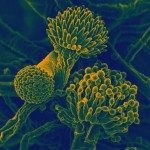Link to Pubmed [PMID] – 22836791
Fly (Austin) 2012 Jul-Sep;6(3):193-204
Drosophila melanogaster is a robust model to investigate many biological problems. It is however prone to some infections, which may endanger fly stocks if left unchecked for. One such infection is caused by an obligate fungal intracellular parasite, Tubulinosema ratisbonensis, which can be found in laboratory stocks. Here, we identify and briefly characterize a T. ratisbonensis strain that was infesting our Drosophila cultures and that required intensive measures to contain and eradicate the infection. We describe the phenotypes of infested stocks. We also report PCR-based techniques that allow the detection of infested stocks with a high sensitivity. We have developed a high-throughput qPCR assay that allows the efficient parallel screening of a large number of potentially-infested stocks. We also have investigated several prophylactic measures to prevent the further contamination of stocks, namely UV-exposure, ethanol treatment, bleaching, and desiccation. Bleaching was found to kill all spores. Other treatments were less effective but were found to be sufficient to prevent further contamination of noninfested stocks. Two treatments were efficacious in curing infested stocks (1) bleaching of eggs and subsequent raising of the larvae in clean vials; (2) fumagillin treatment. These cures only work on stocks that have not become too weak to withstand the procedures.
